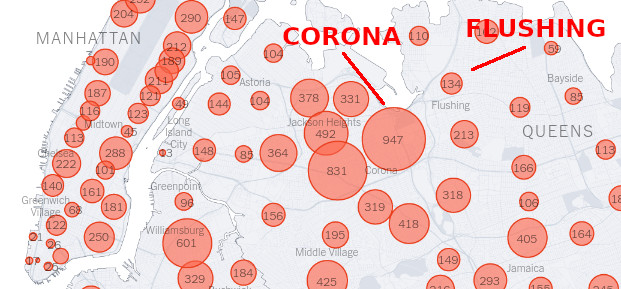Flushing and Corona are two adjacent neighborhoods in Queens, NY. They are both working-class immigrant neighborhoods whose residents experience high degrees of covid comorbidities like hypertension.
1/
1/
Both neighborhoods are full of people who work similar jobs in food service, cleaning, construction and transportation. Most lack health insurance and half of the residents in each neighborhood share a room with at least one other person.
2/
2/
Despite these similarities, their pandemic outcomes are wildly different. Corona is the epicenter of the NYC outbreak; Flushing has one of the city& #39;s lowest rates of infection.
https://thecity.nyc/2020/05/the-life-and-death-divide-between-flushing-and-corona.html
3/">https://thecity.nyc/2020/05/t...
https://thecity.nyc/2020/05/the-life-and-death-divide-between-flushing-and-corona.html
3/">https://thecity.nyc/2020/05/t...
Writing in @THECITYNY, @annjychoi and @J__Velasquez propose an intriguing and plausible explanation for the difference: Flushing& #39;s residents are mostly immigrants from Asia whose families warned them early of the pandemic& #39;s seriousness, so they took precautions earlier.
4/
4/
Infectious disease spread is an exponential phenomenon; that means that once it starts, it spreads FAST. But the merciful flipside of that is that even small reductions in the spread early on have huge downstream preventative effects.
5/
5/
Which means that the large numbers of Flushing residents who got a jump on working from home and wearing masks made a huge difference. What& #39;s more, there were enough people who were reluctant to shop or work that shopkeepers were forced to shut down early, sparing others.
6/
6/
Asian-Americans in NYC have the lowest rate of pandemic hospitalization. Kezhen Fei, a biostatistician quoted in the piece, says "A lot of Chinese people in New York City were probably more aware of the situation earlier."
7/
7/
Meanwhile, across a highway in Corona, the residents weren& #39;t hearing the same warnings, so they were later to take precautions. And, since being poor in America means no social safety net or health care, they got more sick, more quickly. Many died.
8/
8/
Corona is predominantly Latinx. Latinx people are disproportionately likely to become infected, to sicken and to die from coronavirus. They are among the poorest people in America, so they are more likely to have untreated chronic illness.
9/
9/
They& #39;re more likely to be in economic precarity, which means both more crowded living circumstances and greater likelihood of working the kind of front-line job that puts them at risk and offers inadequate protection.
10/
10/
Naturally, people who work these jobs don& #39;t have an economic cushion that would let them quit to protect themselves.
This is true of the people of Flushing, too - the early warnings they got from family abroad made a gigantic difference to their outcomes.
11/
This is true of the people of Flushing, too - the early warnings they got from family abroad made a gigantic difference to their outcomes.
11/
Some important takeaways.
* NYC is incredibly ethnically segregated
* Official reluctance to take decisive action early killed many people, especially poor people
* A widespread, vivid picture of the costs of pandemic is an important and effective prophylaxis
12/
* NYC is incredibly ethnically segregated
* Official reluctance to take decisive action early killed many people, especially poor people
* A widespread, vivid picture of the costs of pandemic is an important and effective prophylaxis
12/
"De Blasio and city Health Commissioner Oxiris Barbot spent crucial days in March attempting to reassure New Yorkers to carry on with activities."
eof/
eof/

 Read on Twitter
Read on Twitter


